EARLS COURT
Page 56
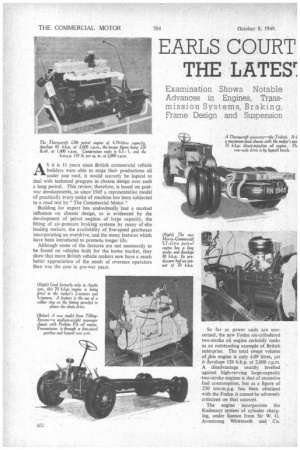
Page 57
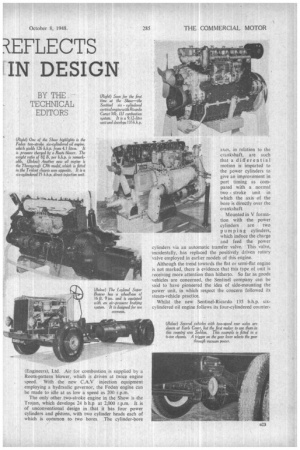
Page 58
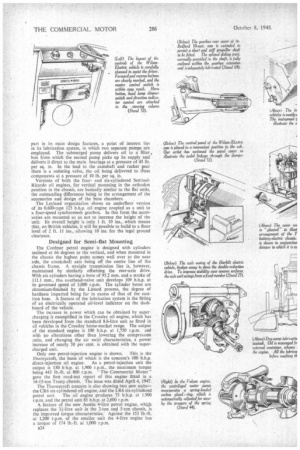
Page 59

Page 60
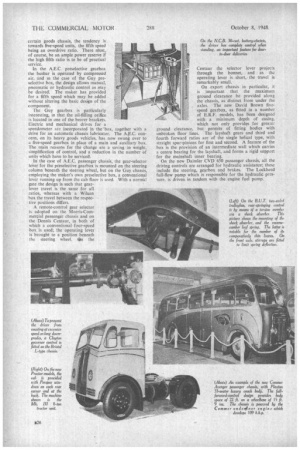
Page 61
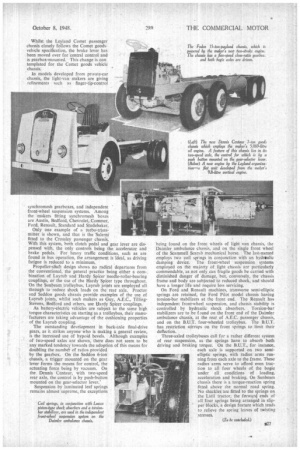
If you've noticed an error in this article please click here to report it so we can fix it.
REFLECTS
THE LATES': IN DESIGN
As it is 11 years since British commercial vehicle builders were able to stage their productions all under one roof, it would scarcely be logical to deal with technical progress in chassis design over such a long period. This review, therefore, is based on postwar developments, as since 1945 a representative model
of practically every make of machine has been subjected to a road test by "The Commercial Motor."
Building for export has undoubtedly had a marked influence on chassis design, as is evidenced by the development of petrol engines of large capacity, the fitting of air-pressure braking systems by many of 4he leading makers, the availability of five-speed gearboxes incorporating an overdrive, and the many features which have been introduced to promote longer life.
Although some of the features are not necessarily to be found on vehicles built for the home market, they show that more British vehicle makers now have a much better appreciation of the needs of overseas operators than was the case in pre-war years. So far as power units are concerned, the new Foden six-cylindered two-stroke oil engine certainly ranks as an outstanding example of British enterprise. The total swept volume of his engine is only 4.09 litres, yet it develops 126 b.h.p. at 2,000 r.p.m. A disadvantage usually levelled against high-revving large-capacity two-stroke engines is that of excessive fuel consumption, but as a figure of 250 ton-m.p.g. has been obtained with the Foden it cannot be adversely criticized on that account.
The engine incorporates the Kadenacy system of cylinder charging, under licence from Sir W. G. Armstrong Whitworth and Co. (Engineers), Ltd. Air for combustion is supplied by a Roots-pattern blower, which is driven at twice engine speed. With the new C.A.V injection equipment employing a hydraulic governor, the Foden engine can be made to idle at as low a speed as 200 r.p.m.
The only other two-stroke engine in the Show is The Trojan, which develops 24 b h.p at 2,000 r.p.m. It is of unconventional design in that it has four power cylinders and pistons, with two cylinder heads each of which is common to two bores The cylinder-bore axes, in relation to the crankshaft, are such that a differential motion is imparted to the power cylinders to give an improvement in port timing as compared with a normal two stroke unit in which the axis of the bore is directly over the crankshaft.
Mounted in V formation with the power cylinders are two pumping cylinders, which induce the charge and feed the power cylinders via an automatic transfer valve. This valve, incidentally, has replaced the positively driven rotary valve employed in earlier models of this engine.
Although the trend towards the flat or semi-flat engine is not marked, there is evidence that this type of unit is receiving more attention than hitherto. So far as goods vehicles are concerned, the Sentinel company can be said to have pioneered the idea of side-mounting the power unit, in which respect the concern followed its steam-vehicle practice.
Whilst the new Sentinel-Ricardo 135 b.h.p. sixcylindered oil engine follows its four-cylindered counter
part in its main design features, a point of interest lies in its lubrication system, in which two separate pumps are employed. The submerged pump delivers oil to a filter, box from which the second pump picks up its supply and delivers it direct to the main . bearings at a pressure of 45 lb. per sq. in. In the lead to the camshaft and rocker gear there is a reducing valve, the oil being delivered to these components at a pressure of 10 lb. per sq. in.
Versions of both the fourand six-cylindered SentinelRicardo oil engines, for vertical mounting in-the orthodox position in the chassis, are basically similar to the flat units, the outstanding differences being in the arrangement of the accessories and design of the base chambers.
The Leyland organization shows an underfloor version of its 0.600-type 125 b.h.p. oil engine coupled as a unit to a four-speed synchromesh gearbox. In this form the accessories are mounted so as not to increase the height of the unit. Its overall height is only 1 ft. 10 ins., which means that, on British vehicles, it will be possible to build to a floor level of 2 ft. 11 ins., allowing 10 ins, for the legal ground clearance.
Designed for Semi-flat Mounting The Conimer petrol engine is designed with cylinders inclined at 66 degrees to the vertical, and when mounted in the chassis the highest point comes well over to the near side, the crankshaft axis being off the centre line of the chassis frame. A straight transmission line is, however, maintained by similarly offsetting the rear-axle drive. With six cylinders having a bore of 95.2 mm. and a stroke of 111.1 mm., this overhead-valve unit develops 109 b.h.p. at its governed speed of 3,000 r.p.m. The cylinder bores are chromium-finished by the Listard process, the degree of hardness imparted being far in excess of that of the castiron base. A feature of the lubrication system is the fitting of an electrically operated oil-level indicator on the dashboard of the vehicle.
The increase in power which can be obtained by supercharging is exemplified in the Crossley oil engine, which has been developed from the standard 8.6-litre unit as fitted in all vehicles in the Crossley home-market range. The output of the standard engine is 100 b.h.p. at 1,750 r.p.m. and with no alterations other than lowering the compression ratio, and changing the air swirl characteristics, a power increase of nearly 50 per cent. is obtained with the supercharged unit.
Only one petrol-injection engine is shown. This is the Thornycroft, the basis of which is the concern's 100 b.h.p.
direct-injection oil engine. As a petrol-injection unit the output is 150 b h.p. at 1,900 r.p.m., the maximum torque
being 445 lb.-ft. at 800 r.p.m. The Commercial Motor" gave the first road-test report of this engine fitted in a 14-I5-ton Trusty chassis. The issue was dated April 4, 1947.
The Thornycroft concern is also showing two new units— the CR6 six-cylindered oil engine, and the LR6 six-cylindered petrol unit The oil engine produces 75 b.h.p. at 1,900 r.p.m. and the petrol unit 85 b.h.p. at 2,600 r.p.m
At feature of the new Austin 4-litre petrol engine, which replaces the 31-litre unit in the 2-ton and 5-ton chassis, is the improved torque characteristics. Against the 153 lb.-ft. at 1,200 r.p.m. of the smaller unit the 4-litre engine has a torque of 174 lb.-ft. at 1,000 r.p.m.
B24
The largest oil engine to be fitted in a passenger chassis is the new Daimler 10.6-litre unit, Based on the concern's 8.6-litre engine, its output at 1,700 r.p.m. is 123 b.h.p., with a maximum torque of 445 lb.-ft. A noteworthy point in the engine is the elimination of external leads in the lubrication system, as the oil is now led through galleries formed in the crankcase casting.
A design feature which has been directly influenced by building for export is concerned with the machining of cylinder blocks so that components can be mounted on the right or left as desired. All A.E.C. 9.6-litre engines are so constructed, as is the new Dennis unit for 5-ton chassis. The 10.35-litre Meadows engine, as fitted in the Guy passenger chassis, and in Tilling-Stevens and Scammell machines, also embraces this characteristic.
Two excellent examples of unit construction of engine gearbox and final drive, arefound in the new Scammell Scarab mechanical horse, and the Jeri-Tug. Included in the outstanding advantages of this form of construction are ease of servicing, and freedom from engine fumes and noise in the cab. The short drive shafts, and the absence of the normal type of propeller shaf. make for greater transmission efficiency.
Incorporated in the Crossley 8.6-litre engine is a floating suction filter which ensures that only clean oil is drawn from the top of the sump, it being assumed that all contaminating matter will fall to the bottom of the sump. In the fourcylindered oil engine which powers, the Albion Clansman and Chieftain goods chassis, a means for automatically varying the timing of the injection is employed, This is achieved by centrifugal means, the mechanism being incorporated in the fuel-pump drive. Fuel economy, increased power and steady idling are the outstanding advantages of the system.
A Long-stroke Petrol Engine
The new Morris-Commercial long-stroke, side-valve petrol engine is an alternative unit to the Saurer-pattern oil engine in the maker's passenger and 5-ton goods-chassis range. Of 3j-litre capacity—theobore is 100 mm. and the stroke 120 mm.—the engine develops 80 b.h.p. at 3,000 r.p.m., the torque being 2,150 lb.-in. at 1,750 r.p.m. The oil engine has a light-alloy crankcase and cylinder-block casting, making for a big reduction in overall weight. The largest oil engine exhibited is the Meadows 15.9-litre unit, which produces 180 b,h.p. at 1,650 r.p.m. In view of its size and power it will doubtless have applications other than for road vehicles.
Whilst the all-crash gearbox is still with us, it is being gradually supplanted by those of the constant-mesh and synchromesh types, whilst the more expensive combination of fluid coupling and pre-selective epicyclic gearbox is now finding a much widei application. In the light and medium range of passenger chassis the tendency is to employ constant-mesh boxes, a few examples being Seddon, JNSN, Bedford and Morris-Commercial In the case of MorrisCommercial, an auxiliary gearbox, with direct drive on top, is offered as the alternative to a two-speed axle With the exception of the lightest types of chassis, gearboxes providing a minimum of four forward speeds are fitted, and in the case of single-decker passenger chassis and n25 certain goods chassis, the tendency is towards five-speed units, the fifth speed being an overdrive ratio. There must, of course, be an ample power reserve if the high fifth ratio is to be of practical service.
In the A.E.C. preselective gearbox the busbar is operated by compressed air, and in the case of the Guy preselective box, thc design allows manual, pneumatic or hydraulic control as may be desired. The maker has provided for a fifth speed which may be added without altering the basic design of the component.
The Guy gearbox is particularly interesting, in that the oil-filling orifice is located in one of the bearer brackets. Electric and mechanical drives for a speedometer are incorporated in the 'box, together with a drive for an automatic chassis lubricator. The A.E.C. concern, on its heavy .goods vehicles, has now swung over to a five-speed gearbox in place of a main and auxiliary box. The main reasons for the change are a saving in weight, simplification of control, and a reduction in the number of units which have to be serviced.
In the case of A.E.C., passenger chassis, the gear-selector lever for the preselective gearbox is mounted on the steering column beneath the steering wheel, but on the 'Guy chassis, employing the maker's own preselective box, a conventional lever running up from the cab floor is used. With a normal gate the design is such that gearlever travel is the same for all ratios, whereas with a Wilson box the travel between the respective positions differs.
A i.emote-control gear selector is adopted on the Morris-Commercial passenger chassis and on the Dennis Centaur, in both of which a conventional four-speed box is used; the operating lever is brought to a position beneath the steering wheel. Ian the
Centaur the selector lever projects through the bonnet, and as the operating lever is short, the travel is remarkably small.
On export chassis in particular, it is important that the maximum ground clearance be provided along the chassis, as distinct from under the axles. The new David Brown fivespeed gearbox, as fitted in a number of E.R.F. models, has been designed with a minimum depth of casing, . which not only provides for greater ground clearance, but permits of fitting bodies with unbroken floor lines. The layshaft gears and third and fourth forward ratios are of the single helical type, with straight spur-pinions for first and second. A feature of the box is the provision of an intermediate wall which carries a centre bearing for the layshaft, and forms a rigid support for the mainshaft inner bearing.
On the new Daimler CVD 650 passenger chassis, all the driving controls are arranged for hydraulic assistance; these include the steering, gearbox and brakes. The Lockheed full-flow pump which is responsible for the hydraulic pressure, is driven in tandem with the engine fuel pump. Whilst the Leyland Comet passenger chassis closely follows the Comet goodsvehicle specification. the brake lever has been moved over for central control and is gearbox-mounted. This change is con ternplated for the Comet goods vehicle chassis.
In models developed from private-car chassis, the light-van makers are giving refinements such as finger-tip-control synchromesh gearboxes, and independent " front-wheel suspension systems. Among the makers fitting synchromesh boxes are Austin, Bedford, Chevrolet, Commer,
Ford, Renault, Standard and Studebaker. Only one example of a turbo-transmitter is shown, and that is the .Saierni fitted to the Crossley passenger chassis. With this system, both clutch pedal and gear lever are dispensed with, the only controls being the accelerator and brake pedals. For heavy traffic conditions, such as are found in bus operation, the arrangement is ideal, as driving fatigue is reduced to a minimum.
Propeller-sHaft design shows no radical departures from the conventional, the general practice being either a combination of Layrub and Hardy Spicer needle-roller-bearing couplings, or the use of the Hardy Spicer type throughout, On the Sunbeam trolleybus, Layrub joints are employed all through to reduce shock loads on the rear axle. Proctor and Seddon goods chassis provide examples of the use of Layrub joints, whilst such makers as Guy, A.E.C., TillingStevens, Bedford and others, use Hardy Spicer couplings. As battery-electric vehicles are subject to the same high torque characteristics on starting as a trolleybus, their manufacturers are taking advantage of the cushioning properties of the Layrub coupling.
The outstanding development in back-axle final-drive gears, as it strikes anyone who is making a general review, is the increased use of hypoid bevels. Although examples of two-speed axles are shown, there does not seem to be any marked tendency towards the adoption of this means for doubling the numb& of ratios provided by the gearbox. On the Seddon 6-ton chassis, a trigger mounted on the gear lever forms the means for control, the actuating force being by vacuum. On the Dennis Centaur, with two-speed rear axle, the control is by push-button mounted on the gear-selector lever.'
Suspension by laminated leaf springs remains almost supreme,, the exceptions being found on the front wheels of light van chassis, the Daimler ambulance chassis, and on the single front wheel of the Scammell Scarab mechanical horse. The last-named employs two coil springs in conjunction with an hydraulic damping device. The front-wheel suspension systems employed on the majorty of light chassis are particularly commendable, as not only can fragile goods be carried with diminished danger of damage, but, conversely, the chassis frame and body are subjected to reduced shock, and should have a longer life and require less servicing.
On Ford and Renault machines, transverse semi-elliptic springs are retained, the Ford Pilot model chassis having torsion-bar stabilizers at the front end. The Renault has independent front-wheel suspension, and chassis stability is controlled by hydraulic shock absorbers. Torsion-bar stabilizers are to be blind on the front end of the Daimler ambulance chassis, at the rear of A.E.C. passenger chassis, and on the B.U.T. four-wheeled trolleybus. The B.U.T. has restriction stirrups on the front springs to limit their deflection.
Three-axled trolleybuses call for a rather different system of rear suspension, as the springs have to absorb both driving and braking torque. On the B.U.T., for instance, each axle is supported on two semielliptic springs, with radius arms run ning from each axle to the frame. These radius arms serve to afford even traction to all four wheels of the bogie
under all conditions of loading. acceleration and braking. On Sunbeam chassis there is a torque-reaction spring fitted abovethe normal road spring. No shackles are fitted to the springs on
the Lath l tractor, the fere/aril ends of all four springs being arranged in slip per blocks, a design feature which tends to relieve the spring leaves of twisting stresses.




















































































































